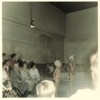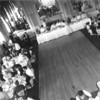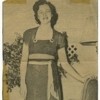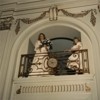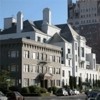Sarah Milne taps a deep well of memories when asked to talk about the Bellevue Club’s importance to her and her family. Just a babe in arms when she first visited the Oakland social club, it was where she learned to swim, and where her own children would later learn. She and her husband celebrated their wedding there, and it’s where they eat Easter and Thanksgiving dinner to this day.
The 48-year-old Milne, a Piedmont mother of two, is a third-generation member of one of the East Bay’s oldest, most elite clubs. Milne’s grandmother became a member in the early 1930s and her family has belonged ever since. She still vividly recalls happy Bellevue memories from childhood.

Bellevue Club postcard, 1986 Credits: Courtesy of the Milne Family 
Aquagirls, 1966 Credits: Courtesy of the Milne Family 
Dinner at the club. Credits: BellevueClub.org 
Sarah Milne’s grandmother, Mrs. Herman Baumann, joined the club in the 1930s. 
A sitting room at the Bellevue. 
Milne wedding reception, 1986 Credits: Courtesy of the Milne Family 
The Bellevue Club today. Credits: Claudia Ward 
A lounge at the club.
“We had an annual Aquacade,” she said. “It was synchronized swimming. We had twenty or thirty kids … and we put on a show once a year. We would wear matching swimsuits and we would have on fancy caps with flowers. I remember one piece that I was in called Red Roses for a Blue Lady and I swam the part of the blue lady. So I had a blue cap and a blue suit and everyone else had red with roses on their caps. … The swimming pool deck was crammed with as many people as they could fit in, all the windows were open and the crowd was two or three deep. It was absolutely wonderful.”
Clubs like the Bellevue abounded at the time. The Adelphian Club, conceived in 1893, featured theatrical performances, hosted political and social discourse, and raised funds for the indigent of Alameda. The Soroptimist club of Oakland, the first in a chain of three thousand international Soroptimist clubs, was founded in 1921 on a platform of achieving the best for women in every sphere of their lives. The Alta Mira Club began offering San Leandro ladies a philanthropic outlet in 1926.
These and other clubs served high society, and their membership rode shotgun with the area’s prosperity. Between the 1920s and the end of World War II, Oakland and its surroundings boomed as the region became home to numerous industries, including metals, auto-making, and shipbuilding.
But women’s clubs gradually became less central to the East Bay’s social fabric. Drinking, dancing, and dressing up never went out of style, but with the spread of auto ownership and construction of the Bay Bridge, San Francisco became the venue for much East Bay socializing. Women also found themselves with more and more social options even as they had less and less time to socialize. And as Oakland’s corporate presence shrunk, the fitness craze boomed, both of which put pressures on clubs that emphasized socializing over athletics.
“Oakland is not what it was in the ’50s,” observes Bellevue attorney Peter Smith. “It’s more of a government center now so you just have a different kind of office. … That’s going to foster a different club activity than if you had 25 Fortune 500 companies.”
Energy has begun returning to downtown Oakland in recent years as entrepreneurs invest big money in dress-code enforcing clubs catering to a young new urban clientele. Stylish, classy cocktails are served up to the money-to-burn crowd at downtown clubs such as Maxwell’s, @Seventeenth, and Air. But well-established legacies of elegance, tradition, and sophistication have not been enough to sustain old-line clubs like the Bellevue.
The Bellevue’s problems are not unique. Other social clubs are trying to cope with the same set of circumstances. Alameda’s Adelphian clubhouse is currently for sale because of declining membership and rising maintenance fees. The Soroptimists launched an international campaign in 2004 to redefine their mission in a bid to generate new interest in the association. Thirty years ago the Alta Mira Club boasted two hundred members; today it serves only 75, opening its doors to nonmembers six days a week in an effort to stay alive.
Perhaps the grandest women’s club of all survived the Great Depression, a handful of wars, its own checkered legacy of discrimination, even feminism. But now the eighty-year-old Bellevue is imperiled by a mountain of debt and a membership that has dwindled for decades. Although the club occupies one of the most scenic locations in all of Oakland, it costs more to maintain the facility than dues generate and the Bellevue is losing members to death or disinterest faster than it’s gaining new ones.
“It’s an anachronism,” Smith said. “It’s not just the concept of a club but it’s the concept of a private club organized around social first and athletic second. Can it exist in a downtown arena where it looks like health is first and social sort of a distant thing you do back at your house?”
That is the question at the heart of the Bellevue’s financial crisis and the leadership struggle it provoked. After the club’s board of directors suggested in January that it was time to shutter the Bellevue, another group of members rose up to struggle for control of the facility — fearful that if it ever closed, it would never reopen.
The fight to save the Bellevue was on.
The Bellevue graces the shores of Lake Merritt on a gently curving street where even fifteen miles per hour seems too fast. Its muted opulence is discreetly heralded by a foot-long gold nameplate with scrolling script. Secluded terraces, balconies, and windows overlook some of the most serene, expansive views to be found anywhere in Oakland. Motivation for the name Bellevue — French for “beautiful view” — becomes obvious just by standing outside the club’s entrance. The five-story clubhouse reminds its members who they are and what they value: comfort, security, friends, sophistication. It has been a place for members to compete in contract bridge tournaments, learn to play mah-jongg, grab a workout in the athletic center, or be led on scenic lakeside walks. Feel like attending a lecture series about the architecture of the new de Young Museum? Maybe your ear calls for classical music on a lazy Sunday afternoon? Perhaps you hunger for an informative talk about shoe design?
Entering the club itself is like taking a similar step back in time. Walking into the lobby, a visitor can’t help but look up and spin around to take in the surrounding balcony. The halls and walls are festooned with original landscapes, portraits, and still lifes. The carpets are muted and clean, with quiet colors lining each space. Pale, faded pinks, mint greens, flower patterns: Everything here was once elegant. Floral patterns dot the upholstery throughout the clubhouse. Wooden and glass phone booths beneath the grand staircase offered privacy to the generations before cell phones. If Hollywood were to film a sequel to The Shining, the Bellevue would be a perfect stand-in for that movie’s mountain retreat.
“It’s a jewel,” says insurance consultant and club publicist Jana Hardy. “She is old, but she has great bones.”
Three different rooms are dedicated just to playing cards. In one, square tables are scattered randomly near a bar with a thick marble counter. In another room, which sports a large mirrored wall, rows of chairs face a podium in front of the fireplace. The view from the window is of ducks grazing on a grassy field with Lake Merritt and the Oakland hills in the background.
Such tranquility befits the Bellevue, but it’s hard to imagine the club bustling. In fact, it feels like a place where a talker might expect to be shushed. At 7:30 in the morning, when most other gyms are packed with motivated exercise-aholics, the Bellevue’s facility is practically empty. The clubhouse offers patrons a workout room filled with mostly outdated exercise equipment. No one is using the grand, three-lane pool. No one is sweating out their toxins in the white-tiled private steam rooms. Every stationary bike is indeed stationary. Walking through the workout section of the club, a woman in her fifties is the only person using a treadmill.
“Where can you find a heated, indoor, Olympic-style swimming pool in the East Bay with only three people in it?” Hardy asks. “You can’t. This is the secret pool of the East Bay!”
A jolly-looking woman with salt-and-pepper hair and round Benjamin Franklin-style spectacles, Hardy is one of the fresh faces hoping to coax the club into the 21st century. Earlier this month, she threw a successful black-tie optional Oscar celebration at which members won door prizes and watched the telecast together. She also hopes to expand the club’s card-game offerings beyond bridge, proclaiming with a schoolgirl’s exuberance, “I want to bring Texas Hold ‘Em here!”
With most members in their seventies and eighties, the 57-year-old Hardy is a spring chicken. She uses the pool regularly and adores the club’s quiet beauty. Despite having only been a full-time member for the past thirteen months, she is clearly in love with the place.
“When I walk into the Bellevue Club, I think of my grandmothers, in San Francisco, with the gloves, pillbox hats, going to town,” she said. “They would have belonged to a club like this.”
The club known today as the Bellevue was founded as the Women’s Athletic Club in 1926, six years after the Nineteenth Amendment granted the fairer sex the right to vote. The goal of the club’s three founders was to provide a social scene for the newly empowered ladies of the East Bay. Despite their new political rights, American women were still confined to traditionally subordinate roles in society.
Founding president Mrs. Eugene K. Sturgis, along with her two cofounders, Mrs. Louis J. Breuner and Mrs. Waldron Gregory, began holding weekly meetings in private residences until a site for the club was located. Interest was intense, and as membership and activities grew, club leaders began scouting for the perfect location. They settled on the site of the historic Wild Duck Inn on the shores of Lake Merritt. The land was purchased in December 1926, and groundbreaking ceremonies were held the next September.
The clubhouse became a reality with an investment raised largely through memberships sold before the site was even selected. The goal was to create a space that embodied the atmosphere, appearance, and intimacy of a home. Completed March 11, 1929, the club held a series of six gala dinner dances to accommodate all the members who wished to participate.
In 1932, the Oakland Tribune devoted three long articles to up-and-coming women’s clubs, describing the Bellevue as “the center for a coterie of clubwomen who combine cultural studies with informal social life.” But the Bellevue was hardly alone. According to the Tribune, approximately 35,000 East Bay women belonged to more than 35 different clubs focusing on social, cultural, or athletic pursuits.
“The clubwoman has arrived!” the author wrote. “She has attained an enviable position of respect and consideration claimed by those who have done most for civic, social and cultural development. Perhaps nowhere is this change more evident than in the Eastbay, where the clubwoman’s growth has been analogous with the progress of every agency designed for community betterment.”
But despite their dedication to community betterment, the Women’s Athletic Club only admitted white, non-Jewish, and nonworking women. “It was a social club and there was absolute discrimination going on — discrimination against men, against minorities, blacks, Hispanics, Asians,” Hardy said. “It was just the white gals from Piedmont.”
The club’s discrimination was par for the course with such facilities. No one contacted for this story could recall exactly when Jews and nonwhites were first accepted. But in 1985, as membership numbers shrank, the club began accepting men as patrons. And in 1992, hoping to catch the eye of those who dismissed it as a women’s-only fitness facility, the board formally changed the name to The Bellevue Club.
The club also reached out to community leaders. For instance, Alameda County Sheriff Charles Plummer first became involved in the Bellevue after the death of another social club that he belonged to. In 2000, after sixteen years in business, The Lakeview Club, Oakland’s premier business club, closed its doors atop the Kaiser Building. Plummer and a handful of other Lakeview members were then invited to join the Bellevue.
But none of these efforts were sufficient to stem the enrollment decline. Part of the reason was the challenge of competing for members with clubs much more in tune what young people want. For instance, Club One, a mixed-gender fitness chain with a dozen outlets scattered throughout the greater Bay Area, boasts close to seven thousand members at its Oakland site — the largest of the twelve — and features state-of-the-art equipment, and well-trained instructors.
Founded in 1991, the upscale gym gives members a place to work out, swim laps, take a salsa or hip-hop dance class, meditate, socialize with fellow patrons, or just relax in the locker room. Despite its dual gender acceptance, the club places great emphasis on women’s health and offers many activities that cater to women in general. General manager Patricia Kirk, a 47-year-old former fitness trainer who is writing a book about women in management, said what drives women today is movement.
In the social realm, meanwhile, the Internet has emerged as a powerful new way to create ad hoc social groups. Web sites such as Meetup.com offer visitors a way to meet like-minded individuals in a particular area. Anyone from punk moms to anime fans to dodgeball players can find a local group catering to their interests. “Meetups are real-world get-togethers of neighbors who share common interests,” company spokesman Myles Weissleder explained. “It’s not an Internet thing — we’re talking real face-to-face gatherings. Our mission is to help revitalize and strengthen local community in America. We like to say we’re using the Internet to get people off the Internet.”
Finally, clubs like the Bellevue must cope with the new realities of womanhood. “Women have never been so pressed in modern America as they are today,” says Nancy Rubin, an author and journalist who specializes in women and social history. “In the early ’80s they were having trouble in clubs, and it’s obviously accelerated. … Most women are very pressed for time. It’s a peak time for women to be raising children and also a peak time for getting back into their careers.”
Third-generation member Milne says the Bellevue has not updated its offerings to make it more attractive to younger people with children. It did a good job transitioning from her grandmother’s generation to her mother’s, but “somehow that transition didn’t work to my generation,” she said. “At 48, I’m one of the kids, which is not a recipe for long-term success.”
As the Bellevue’s membership declined and its debts mounted, in 2002 the board asked a nonprofit auditor to study its demographics. The audit suggested that the club abandon its lakefront facility and find a smaller and cheaper location elsewhere in Oakland. But the board chose to remain open, brainstorming about ways for the club to stay viable.
One proposal involved building a new, sixteen-story residential condominium adjacent to the club. The idea was to have as many members as possible buy one of the proposed building’s 62 units. But when too few members expressed interest, then-president Connie Hosemann recalls, the idea just fizzled.
That’s when the board began paving the way to sell the facility. The bylaws were changed to allow directors to make key decisions without membership approval — up to and including selling the building. In late January of this year, the directors decided that time had arrived.
The plan was to sell off club assets, pay off the debt, and walk away. Depending on whom you talk to, the land and building are worth anywhere from $8 million to $22 million. If the club were to be sold, Hardy said the purchaser would have many hurdles to jump. Proceeds of any sale would first go to pay off the real estate agents, then the debt, then any other notes the club owed, Hardy said. And while the waterfront concrete structure doesn’t need to be retrofitted, there is a lot of deferred maintenance. In the end, Hardy estimated, members with equity would receive $20,000 to $25,000 apiece, depending on the sale price. Then the Bellevue would be no more.
No member of the board would comment on their vote to shut the club. But Smith, the club’s lawyer, said the decision was based on the sad reality that expenses greatly exceed revenues. “They are slowly losing members just on the basis of attrition, and during that same time, as they lose members and they lose the source of dues, new members don’t make up the gap.”
Dues currently range from $100 to $180 a month depending on the type of membership sought. One form of $100 membership provides access only to the athletic facility. For the same price, a member also can use all club facilities except the fitness center and pool. Teachers, firefighters, police officers, military personnel, and members of service clubs also qualify for public-service memberships at that price. None of these memberships, however, include voting rights, reciprocal memberships, or equity in the Bellevue. Full membership costs $180 a month along with a $500 initiation fee for people forty years and older, and $105 a month with a $250 initiation fee for younger people.
The Bellevue earns additional money by hosting and catering parties, events, and meetings. The main dining room can accommodate 165 people for a sit-down service or 200 for a stand-up reception. The club also houses seven bed-and-breakfast-style hotel rooms that range in price from $80 for a queen bed with no view to $155 for a three-bedroom suite with a lakeside terrace. Rooms can be rented by Bellevue members or visitors of affiliated out-of-town clubs.
Smith said the club has a monthly payroll of $90,000 and a PG&E bill of $12,000 — and that doesn’t even consider the maintenance costs involved in keeping up a facility with marble fireplaces, gilded moldings, flowing draperies, and crystal chandeliers. Because dues only bring in $60,000 each month, the club has to bring in tens of thousands of dollars more in operating revenue each month to avoid losing money.
In recent years, it has fallen far short of that mark. Membership today stands at approximately four hundred members, well down from the thousands who once flocked to the club’s USO-style dances during World War II.
The board’s decision to throw in the towel provoked a firestorm at the normally tranquil club. Three days after the announcement, members decided at a special meeting to reopen the club for sixty days in a last-gasp attempt to save it. A new group calling itself “Concerned Members of the Bellevue” and consisting of a relatively diverse portfolio of patrons began drumming up support for its plan. The group proposed replacing the existing board — which consisted solely of white women in their sixties and seventies — with a new slate dedicated to reenergizing the club.
“They just aren’t any good at changing directions,” Milne said of the existing board. “The club’s been on the brink for years. We’ve got a very loyal membership and in the past every time we’ve got really, really close, someone would ride to the rescue. But nothing systemic ever changed. So we’re now at a point where the fundamentals have to change or there is really no point.”
Jim Ratliff, a 49-year-old economist who lives across Lake Merritt from the club, described a rift within the membership between the Piedmont-based old guard and a new guard more likely to live in Oakland. “It’s hard to explain,” he said. “There is sort of a Piedmont-Oakland split. Even though the club is in Oakland, a lot of the board members are a bunch of Piedmont people that are sort of in solidarity with one another.
“I’d like the club to develop into something that offers more for the new generations of members. … I think it has a lot of potential. It is a great resource in many ways. I’m also pro-democracy, and the existing board was so secretive.”
Oakland consultant Margo Murray also was dissatisfied with the status quo. A Bellevue member since 1991, Murray belongs to the club not for its athletic facility or rich history, but because it’s a nice place to host seminars, meetings, and lunches — which she says she did more of before some of the building’s guest rooms were converted into office space for employees. “When we had twelve to fourteen guest rooms, I could do workshops and seminars,” she said. “We were bringing significant revenue to the club.”
Like Ratliff, Murray also chafed at the board’s secrecy. “The bylaws are the worst I have ever seen and I have belonged to a lot of organizations.”
Alameda County Sheriff Charles Plummer, one of the candidates for the new board, also got involved out of frustration with how the board was doing business. “They’ve kinda operated in the dark, treating us like mushrooms, feeding us bullshit,” the plain-spoken 75-year-old said of the all-female board. “They are all nice people. A lot of them are ancient though. I’m old, but they are old old.
“I hope that we get a slate of officers that will not be defeatists and will be proactive at finding activities that will keep the club open.”
The board approved the membership’s call for a March 12 meeting to vote on whether to replace the board.
Members arrived almost an hour before the board meeting. Rain was coming down in sheets, and the sky was a single gray cloud with no end in sight. Lincoln Town Cars, Mercedes-Benzes, and Jaguars lined the club’s driveway. Some slowly walked from their cars with umbrellas in hand. Others used canes, walkers, wheelchairs, or electric scooters. Many came dressed in their Sunday best. The rain and the scarcity of parking slowed down the procession.
The meeting was closed to the public and none of the participants would discuss the process on the record. But members clearly did not sit idly by on a day with the potential to be the club’s most important in years. Estimates were that close to 150 people would attend the special all-member meeting. But turnout surpassed that as the dining room, which holds at least 200 people, was packed all the way to the back.
Ratliff began the proceedings by introducing a new slate of board members to the membership. A slide presentation provided details on the ideas the new board hoped to pursue. Suggestions included leasing the fitness facility to a private gym, leasing the kitchen to an entrepreneur for use as a restaurant, and establishing a bed-and-breakfast-style business in the eight hotel rooms on the Bellevue’s third floor. Some of the proposals reportedly were greeted by light applause. Before the meeting, Hardy said of the proposals, “Those are three very up-front, implement-right-away ideas where you transfer the risk and responsibility and you get people in there who are professionals in running those types of businesses.”
After almost an hour and a half, the voting to replace the current board began. Fittingly, the League of Women Voters was tapped with tallying the votes. According to Hardy’s press release, members voted by “a large margin” to recall the sitting board and select a new twelve-member board “committed to keeping the club open.” In October, the club plans to hold its regularly scheduled board elections and replace the interim board. By that time, supporters hope the Bellevue will be back on its feet with a plan of attack for the future.
Demographically, the board now reflects the club’s current face. It consists of two men and ten women, and includes professionals and business leaders from both Piedmont and Oakland.
“The new Board is ready to face the challenges to increase the membership, manage with fiscal accountability, and schedule activities and events that are enjoyed by a diverse membership,” the press release stated.
Bellevue general manager Barbara Maroni generally declined to comment for this story. But before the board meeting, she said the time is now for the club to shore up its house. “It is long overdue,” she said. “The same thing probably happened in 1985 when they decided to accept men. Our goal is to run it more as a business, not just a genteel woman’s club.”
One self-described pessimist, who asked to remain nameless, said the goal is plain and simple: “They either need to raise dues or double membership. It’s that simple.”
Despite the exuberance to get the club back on its feet, Milne concedes that a lot of work remains. “Everyone that I have brought there is just in awe of it. But then they look around and say, ‘Well, there’s nothing really here for me on an ongoing basis.’ … The fewer members you have, the fewer activities you can support.”
But ever the optimist, Milne believes that with the new board, the club has a fighting chance to survive. “It is such a jewel. It is such a unique property and unique feel. It’s an absolutely wonderful and delightful place.”
And when asked if the Bellevue is still the area’s grandest city club, Milne replied, “Oh yes, of course!”





